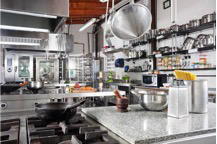There are no easy answers to the question of successful allergen management. Food Safety doesn’t come from buying an expensive machine, and a Hazard Analysis and Risk-Based Preventive Controls plan that’s put away once the auditors leave doesn’t help anyone.
Instead, consistent allergen management is a house that’s rebuilt each and every day—a house built on a foundation of detailed processes, careful training, and constant vigilance. And, while an educated and passionate workforce is the first line of defense against cross-contamination, there are also tools that can help you spot problems quickly and efficiently.
Here we look into several manufacturers’ experience using rapid lateral flow tests to identify traces of gluten and allergen contamination in incoming ingredients and finished products, and also on working surfaces.
Case Study #1
How can rapid allergen tests help your facility gain new business?
Who:
A midsize manufacturer of frozen snacks and appetizers that incorporated many allergens (according to the Food Allergen Labeling and Consumer Protection Act of 2004): eggs, casein, soy, wheat, crustacean, and fish.
What:
An important contract to begin producing frozen breakfast foods for a national brand.
The Catch:
The breakfast foods were free from crustacean and fish, and the brand did not want a “May Contain” statement on their packaging. Before signing a contract, they needed assurance that the facility could successfully protect against accidental fish/crustacean contamination.
The Details:
The facility was already following Good Manufacturing Practices, from careful storage and labeling of allergenic ingredients on to thorough cleaning protocols. Still, they’d maintained a “May Contain” statement on their packaging with the full list of allergens known to be on-site. Could the facility do away with their “May Contain” statement for fish and crustacean, and earn new business?
The quality assurance and food safety team brought in a series of lateral flow kits for detecting both fish and crustacean. They chose a device that would allow their team to work efficiently and accurately:
• No equipment required
• Shelf-stable
• Results in less than 12 minutes
• Test surfaces, foods or liquids (including rinse water) with the same kit
The facility began using the test strips as part of their day-to-day protocol.
After sanitation, tests were run on multiple surfaces, including “easy” surfaces like steel counters and “tricky” ones like joints and flexible conveyor belts. Had the team encountered any positives, they would have stopped everything to re-clean, and then carefully reviewed their Sanitation Standard Operating Procedures (SSOPs).
Once the surfaces were deemed clean, the breakfast items were run on the lines. Samples were pulled from the beginning, middle and end of the production run and tested separately with the lateral flow devices. These same samples were then sent off to a third party lab for quantitative allergen analysis with a more complicated enzyme-linked immunosorbent assay kit.
Ultimately, the facility was able to demonstrate an ability to consistently keep allergenic material out of the breakfast foods and was awarded the contract.
With confirmation that their SSOPs were sufficient for allergen control, the facility was able to reduce the number of kits needed on a regular basis for surface testing. They also reduced the number of tests used for finished products, and the frequency with which samples needed to be sent out for third party validation.
The Upshot:
Thanks to a minor additional expense in the form of lateral flow test kits—more than covered by profit from the new business—the facility simplified their own packaging while attracting new clients.
Case Study #2
How can on-site gluten testing help avoid costly recalls?
Who:
A gluten-free brand of snacks, cookies, and baking mixes with their own facilities.
What:
A series of positive tests on a classic item, indicating unexpected gluten contamination.
The Catch:
There were no new ingredients, and the facility was dedicated gluten-free. Where could the gluten be coming from?
The Details:
The company had been making the product (a baked good) according to the same recipe for years. They always used a lateral flow kit set to 5 ppm, well below the U.S. Food and Drug Administration’s limit of 20 ppm. One day, all 10 batches came back positive.
New samples were tested again with the kit, this time at 10 ppm. Again they were positive; most test lines were faint, but batch 7 had a bright pink line.
A third round of samples was checked at 20 ppm. Batch 7 returned a positive result, and all other batches tested negative.
A fourth round was checked, again at 20 ppm, by a different technician. The tests confirmed that batch 7 was over 20 ppm of gluten, and the other batches had between 5–20 ppm of gluten. Batch 7 was pulled and the others were released.
The lead technician took samples of all ingredients from the corresponding lots to test for gluten at 20 ppm. All ingredients initially tested negative.
Perhaps the contamination came from within the facility? The only gluten in the building was employee lunches; it was deemed highly unlikely that an employee would have brought their lunch out onto the floor—but records were checked and no inconsistencies were found.
The recipe was largely sugar and rice flour, so the technician went back and pulled additional samples. The rice flour continued to test negative. Of 20 bags of sugar, 19 were negative. One bag was positive at 20 ppm and again at 40 ppm.
The culprit was found! The company sent multiple sugar samples to the lab for analysis, confirming the on-site results. The sugar supplier did not knowingly handle any wheat and said they tested each large, homogenized batch of sugar to 20 ppm. Although they might not have wanted to admit it, some form of wheat was entering their sugar supply—and as with all cross-contamination, gluten levels were not homogenous, even after the sugar was thoroughly blended.
While the sugar supplier examined sources and processes, the manufacturer instituted a more frequent test policy for risky items and reaffirmed their commitment to testing at all stages of production.
The Upshot:
Thanks to the quality assurance team’s quick actions and rapid tests, the company was spared from a costly recall and no celiac was accidentally exposed to gluten.
Case Study #3
How can on-site gluten testing reduce costs for small businesses?
Who:
A baker wholesaling gluten-free baked goods to local cafes, restaurants and specialty markets.
What:
Some potential new clients wanted proof that the gluten-free items were in fact legally gluten-free.
The Catch:
The baker operated out of a shared commissary facility that was also used for gluten-containing items. Sending each batch for third-party testing was costly and time-consuming.
The Details:
The baker used only certified gluten-free ingredients but worked in a shared facility where all types of foods were made. The facility organized a separate storage locker dedicated to gluten-free items but could not dedicate a kitchen area as gluten-free.
 The baker spent the first portion of every kitchen session carefully cleaning all surfaces and looking for loose crumbs. After baking, she also sent a sample off to a testing lab for analysis.
The baker spent the first portion of every kitchen session carefully cleaning all surfaces and looking for loose crumbs. After baking, she also sent a sample off to a testing lab for analysis.
The lab results helped the baker maintain a loyal clientele, but they were costly—and it took several days for results. What would she do if a test came back positive? Was there a way to reduce testing expenses without compromising safety?
The baker turned to rapid tests for help. For several weeks, she tested multiple surfaces in the kitchen for gluten contamination. The negative results helped assure her that her current cleaning protocols were eliminating any lingering gluten.
Then, the baker instituted a policy of testing the first and last products of the day with a gluten test set to 5 ppm. Each test cost a fraction of what a lab test cost and the baker had her results in less than 20 minutes. If a test were to come back positive, she could instantly investigate and none of her clients would risk selling a contaminated pastry to a person with celiac disease—but to date, she has had consistent negative results.
The Upshot:
By incorporating lateral flow kits into her routine, the baker was able to reduce the frequency of her third party lab tests from weekly to twice yearly. These “check-ups” provided important certificates of analysis for her clients, and the regular testing provided peace of mind and confidence in her ingredients, working spaces, and gluten-free products.
Manufacturers across the globe are turning to Emport LLC to ensure that incoming ingredients and outgoing products are as gluten- and allergen-free as their customers demand.
GlutenTox Pro has AOAC-PTM validation for foods & surfaces and can be set to 5, 10, 20 or 40 ppm. AlerTox Sticks are easy, qualitative kits for soy, egg, fish, crustacean, peanut, almond and more.
Emily Kaufman is president of Emport, LLC. For more information, visit www.emportllc.com or www.glutentox.com.




